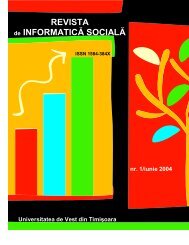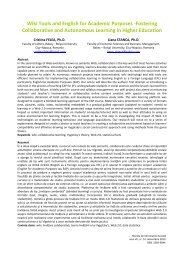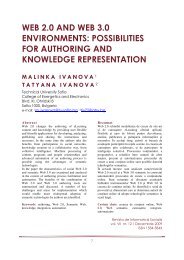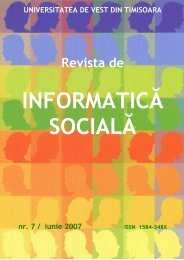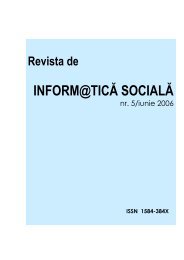No 13 - Journal of Social Informatics / Revista de Informatica Sociala
No 13 - Journal of Social Informatics / Revista de Informatica Sociala
No 13 - Journal of Social Informatics / Revista de Informatica Sociala
You also want an ePaper? Increase the reach of your titles
YUMPU automatically turns print PDFs into web optimized ePapers that Google loves.
4. LOW THRESHOLD OF PARTICIPATION<br />
At least in highly <strong>de</strong>veloped societies, almost anybody is physically able to "Twitter"<br />
anytime and at any places, because so many technical channels (cell phone, Email, Web etc) are<br />
alternatively available, because writing such a short text takes very little effort, and reading<br />
messages is so easy that many <strong>of</strong> them can be absorbed within very short time.<br />
In addition, communicative efforts are reduced because exchanges occur in a completely <strong>de</strong>ritualized<br />
manner. In face-to-face encounters, participants have usually to "open a bracket" in or<strong>de</strong>r<br />
to <strong>de</strong>fine themselves as "mutually accessible": e. g. by directing gazes, formal greeting etc; and they<br />
usually finish their contact by a ritualized "Good bye" (G<strong>of</strong>fman 1971: 79). Twitter does away with<br />
all such ritualistic overhead: messages are reduced to their "real content", without any introductions<br />
and conclusions. Finally, participation is fundamentally facilitated by the fact that in contrast to<br />
Facebook and other <strong>Social</strong> Network Sites, there is no need to construct a personal i<strong>de</strong>ntity, but just<br />
to <strong>de</strong>scribe one's current activities or thought.<br />
Thus, Twitter has the potential <strong>of</strong> expanding the total range <strong>of</strong> human communication by<br />
facilitating exchanges between actors with very weak social ties.<br />
For instance, commercial firms may be able to get critical comments from dissatisfied<br />
consumers who would never articulate their voice on any other channels like phone, FAX, Email or<br />
traditional letters) (Ojeda-Zapata 2008).<br />
Similarly, individuals are better able to permeate all their daily experiences with collegial<br />
commentaries, opinions and evaluations: e. g. while attending a school lesson, watching a film on<br />
TV, visiting a foreign city, dining out in a hitherto unfamiliar restaurant or tasting a new brand <strong>of</strong><br />
wine.<br />
"Downs, a 25-year-old graphic <strong>de</strong>signer, recently wrote a short<br />
post about eating at a local restaurant and not being too impressed. A<br />
friend respon<strong>de</strong>d, saying he liked the place. The two exchanged tweets<br />
about it. 'It's not a big-<strong>de</strong>al topic, but it's nice to be connected,’ Downs<br />
said. ‘You get to share something and get a response. It's fun.'"<br />
(Stickney 2008)<br />
Thus, Twitter may be more potent than other media to erase conditions <strong>of</strong> utter loneliness on<br />
and forever from my life: because wherever I are, I feel socially integrated by remaining embed<strong>de</strong>d<br />
in a fuzzy cloud <strong>of</strong> potential communication partners - even when I don't know who will respond to<br />
my messages at which occasion.<br />
For the same reason, Twitter can glue together centrifugal social aggregates as they emerge<br />
at large local gatherings (e. g. in conferences or vacation resorts).<br />
“How many times have you met some folks at a conference but<br />
forgot to get their number and couldn’t find them later when you wanted<br />
to grab a beer? If you hooked in with them on a Twitter a single message<br />
can tap everyone you’ve met making it easy to find one another. Meeting<br />
up with your friends would also be easier since you could simply Twitter<br />
your location or where you are heading and all <strong>of</strong> your friends will get<br />
the message.”<br />
(Olson 2007)<br />
In contrast to the phone and also to bilateral Email or Instant Messaging, Twitter messages<br />
intru<strong>de</strong> much less into the life <strong>of</strong> receiving individuals because they can easily be ignored and<br />
remain unanswered. The reason is that they are directed to many recipients: so that it sufficient<br />
when few <strong>of</strong> them send an answer. (Osborne 2008).<br />
pag. 9: <strong>Revista</strong> <strong>de</strong> Informatică <strong>Social</strong>ă | Vol. III (<strong>13</strong>) / 2010 | ISSN 1584-384X





